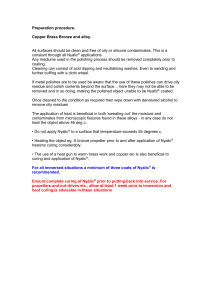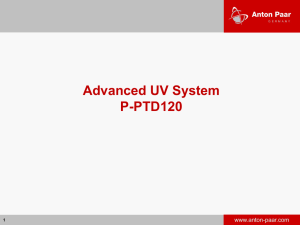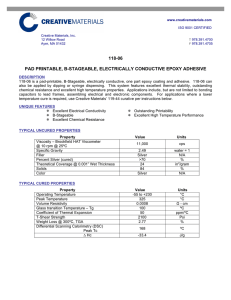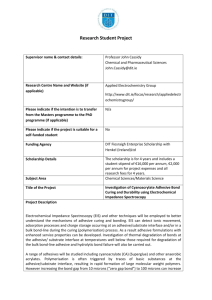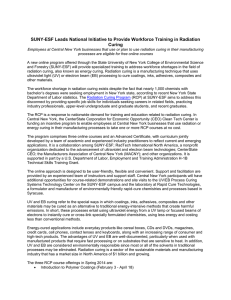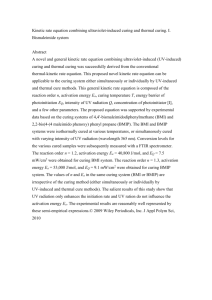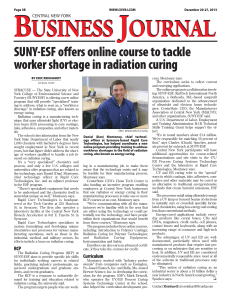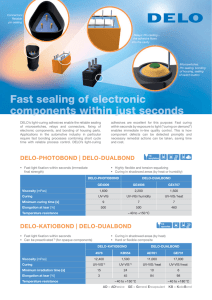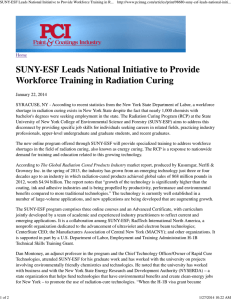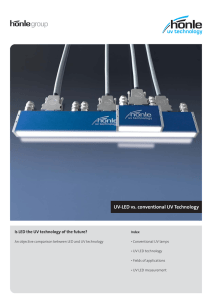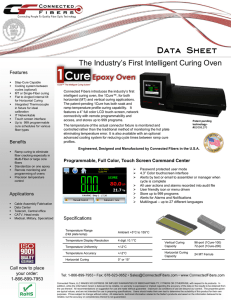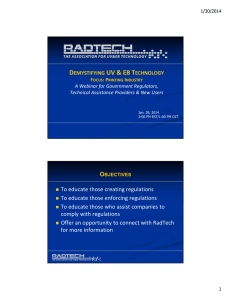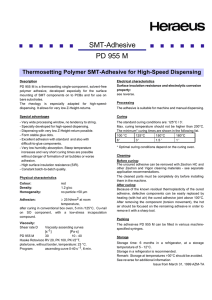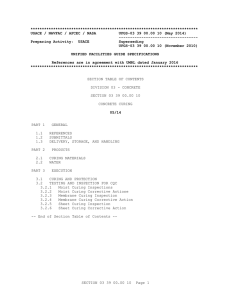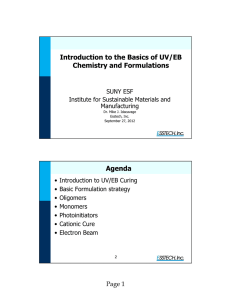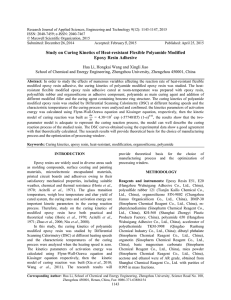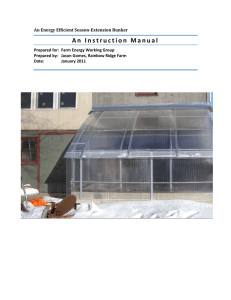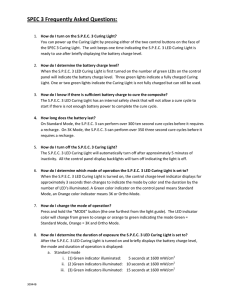All webinars in the series are archived at 4/10/2014
advertisement
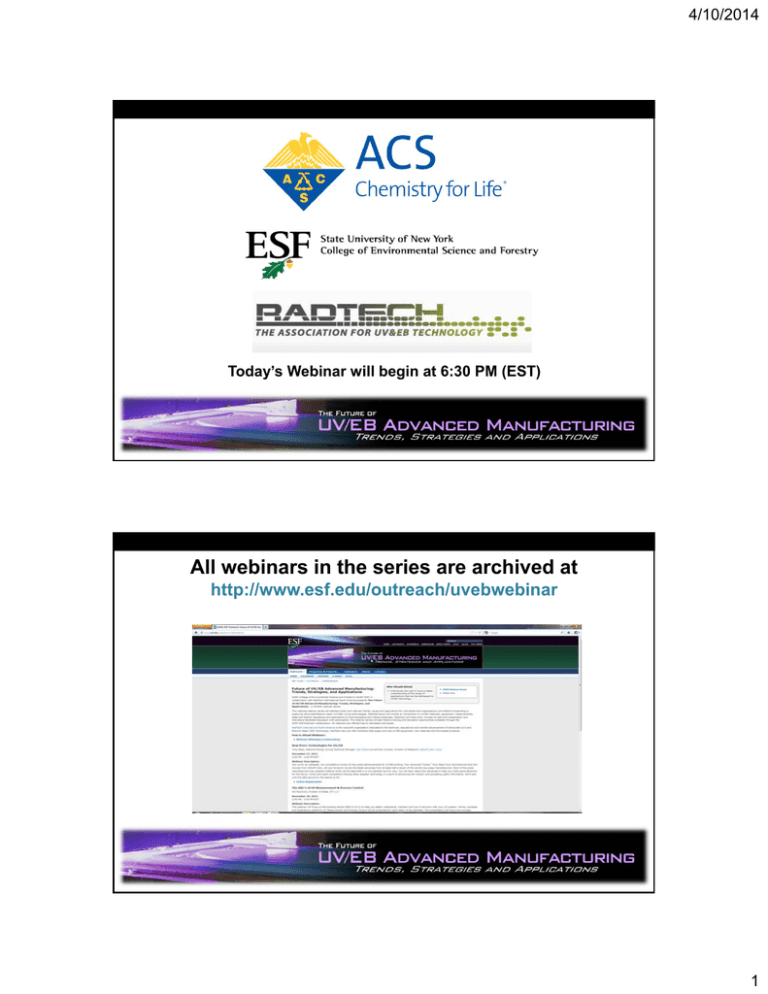
4/10/2014 Today’s Webinar will begin at 6:30 PM (EST) The webinar will be begin shortly. All webinars in the series are archived at http://www.esf.edu/outreach/uvebwebinar 1 4/10/2014 Radiation Curing Program [RCP] SUNY-ESF is offering three online courses in Radiation Curing every fall, spring, and summer term. •Introduction to Polymer Coatings / Dr. Molly Hladik •Radiation Curing of Polymer Technologies / Dr. Susan Bailey •Radiation Curing Equipment, Instrumentation and Safety / Dr. Mark Driscoll, Mr. Dan Montoney Available as non-credit, graduate credit, and as an Advanced Certificate in Radiation Curing from SUNY. •NEW short-course Summer 2014: Principles of Energy Curing Technologies / Dr. Mike Idacavage • Available currently as non-credit, professional development only. For more information and to sign up, visit www.esf.edu/outreach/radcuring May 12‐14, 2014 Chicago, IL Visit the Radiation Curing Program Staff at Booth 119! Learn More at: www.RadTech2014.com 2 4/10/2014 S2 UV Curing Technology A Route to Solvent-free Adhesives and Coatings Stephen Cantor, Ph.D. Chemistry & Technology • What is Radiation Curing? • Chemistry‐Photoinitiators, Monomers & Oligomers • Adhesive Formulation(s) • Advantages • Fluorescent Response for In‐line Inspection • Markets • YouTube Short 3 4/10/2014 Electromagnetic Spectrum Ultraviolet Light UVC 200 nm X‐rays 10-5 nm UVV 1 nm UVA UVB 280 V I S I B L E L I G H T 315 400 600 Infrared 760 Microwaves 1 mm Radiowaves 1m 4 4/10/2014 5 4/10/2014 Spectral Distribution of UV/Vis Metal Halide Bulb Relative intensity 30 25 20 15 10 5 0 200 250 300 350 400 450 Wavelength, nm How Do Light Curable Adhesives Work? • Light Curable Adhesives crosslink using energy provided by ultraviolet (UV) and/or visible light • It is critical that the light source outputs enough energy of the proper wavelength(s) to cure the adhesive • Curing starts when the adhesive is exposed to energy of the proper wavelength(s) and it will stop if light is turned off or removed from the cure area 6 4/10/2014 Absorption Curve of Photoinitiators Relative intensity 30 25 20 15 10 5 0 200 250 300 350 400 450 Wavelength, nm 7 4/10/2014 8 4/10/2014 Why UV/Visible Light Cure Most common answer is speed, but also… One-part systems-no mixing, purging, waste Solvent-free systems In-line inspection Performance Building Blocks for UV Curing • Liquid Monomers: Monoacrylates; Diacrylates; Polyacrylates • Urethane‐acrylate oligomers 9 4/10/2014 ACRYLIC ACID 2‐Hydroxyethylmethacrylate (HEMA) 10 4/10/2014 Isobornyl Methacrylate I TETRAHYDROFURFURYl ACRYLATE (THFA) O CH 2 = C - C - O - CH O 2 H 11 4/10/2014 Viscosity of Water= 1mPa.S at RT 12 4/10/2014 Oligomer Preparation Structure and Mol. Weight Determines Properties of the Final Product 13 4/10/2014 Typical Light Curable urethane acrylate adhesive UV/VIS light P.I. Photoinitiator ADDITIVE for fine tuning MONOMER for specific properties OLIGOMER for basic properties Typical Adhesive Formulation INGREDIENTS Oligomer HEMA IBOA Acrylic Acid THFA EGDMA Thickeners Stabilizers Photoinitiators Adhesion Promoters PERCENT 43.0 6.0 22.0 5.0 10.0 3.0 4.0 2.5 3.0 1.5 *Viscosity will depend on the amount of thickener used 14 4/10/2014 15 4/10/2014 Markets Served Medical Industrial Electronics Core Markets Automotive Optical Electrical Assembly Packaging Aerospace Inspection and Quality Control COLOR CHANGE UPON UV EXPOSURE FLUORESCENT RESPONSE VIA OPTICAL READER 16 4/10/2014 Fluorescing Agent Spectra 17 4/10/2014 Relative intensity 30 25 20 15 10 5 0 200 250 300 350 400 450 Wavelength, nm 18 4/10/2014 Visible light from the UV Blub 19 4/10/2014 Optical Reader to Measure Fluorescent Response 20 4/10/2014 Profile of anesthesia mask 21 4/10/2014 Sidney Hutter Kylix Cubic Heart Vase 22 4/10/2014 Acknowledgments Sartomer‐Henry Miller BASF‐Eugene Sitzmann Dymax ‐ Staff Ellsworth‐Jeff Payne 23 4/10/2014 24
